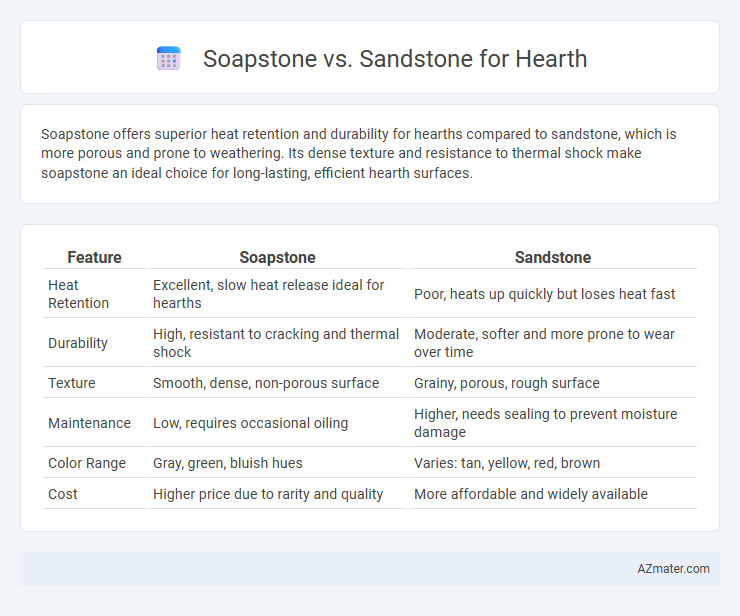Soapstone offers superior heat retention and durability for hearths compared to sandstone, which is more porous and prone to weathering. Its dense texture and resistance to thermal shock make soapstone an ideal choice for long-lasting, efficient hearth surfaces.
Table of Comparison
| Feature | Soapstone | Sandstone |
|---|---|---|
| Heat Retention | Excellent, slow heat release ideal for hearths | Poor, heats up quickly but loses heat fast |
| Durability | High, resistant to cracking and thermal shock | Moderate, softer and more prone to wear over time |
| Texture | Smooth, dense, non-porous surface | Grainy, porous, rough surface |
| Maintenance | Low, requires occasional oiling | Higher, needs sealing to prevent moisture damage |
| Color Range | Gray, green, bluish hues | Varies: tan, yellow, red, brown |
| Cost | Higher price due to rarity and quality | More affordable and widely available |
Introduction to Hearth Materials
Soapstone offers exceptional heat retention and a smooth, non-porous surface ideal for hearths, making it highly durable and resistant to cracking under intense heat. Sandstone, while visually appealing with its natural grain and warm tones, is more porous and less heat-resistant, potentially requiring more maintenance to prevent damage from thermal stress. Choosing between soapstone and sandstone depends on the desired balance of durability, heat performance, and aesthetic qualities for the hearth.
Overview of Soapstone
Soapstone is a dense, heat-retentive metamorphic rock composed primarily of talc, making it exceptionally soft and easy to carve, yet highly durable for hearth applications. Its natural ability to absorb and radiate heat evenly creates efficient and long-lasting warmth, ideal for fireplaces and wood stoves. Unlike sandstone, which is porous and less heat-retentive, soapstone offers superior thermal mass and resistance to cracking under high temperatures.
Overview of Sandstone
Sandstone is a sedimentary rock composed primarily of quartz and feldspar, known for its natural warmth and textured appearance, making it a popular choice for hearths. Its durability and heat resistance allow it to withstand high temperatures, while its porous nature requires proper sealing to prevent staining and damage. Sandstone hearths offer a rustic aesthetic that complements both traditional and contemporary interiors, balancing functionality with visual appeal.
Aesthetic Differences: Soapstone vs Sandstone
Soapstone offers a smooth, matte finish with rich, deep gray to green hues that darken and develop character over time, providing a sleek, modern aesthetic ideal for hearths. Sandstone features a grainy texture with warm, earthy tones ranging from beige to reddish-brown, creating a rustic, natural appearance that complements traditional or country-style interiors. The choice between soapstone and sandstone for a hearth depends on the desired visual appeal--sleek and contemporary versus textured and organic.
Heat Retention and Distribution
Soapstone excels in heat retention and even heat distribution due to its high density and thermal conductivity, making it an ideal choice for hearths that require consistent warmth over time. Sandstone, while aesthetically pleasing, has lower heat retention and distributes heat less evenly because of its porous structure and lower thermal mass. Choosing soapstone for a hearth ensures prolonged heat release and efficient warmth, enhancing comfort during cold months.
Durability and Longevity Comparison
Soapstone boasts exceptional durability and heat retention, making it highly resistant to cracking and thermal shock in hearth applications. Sandstone, while aesthetically pleasing, is generally softer and more porous, which can lead to greater wear and susceptibility to weathering over time. Choosing soapstone for a hearth ensures a longer-lasting, low-maintenance surface capable of withstanding intense and prolonged heat exposure.
Maintenance and Cleaning Requirements
Soapstone hearths require minimal maintenance due to their non-porous nature, resisting stains and moisture effectively. Sandstone, being porous, demands regular sealing to prevent absorption of dirt and moisture, increasing maintenance efforts. Cleaning soapstone involves mild soap and water, while sandstone often needs specialized cleaners to avoid surface damage.
Cost Comparison: Soapstone vs Sandstone
Soapstone hearths typically range from $70 to $150 per square foot, offering durability and natural heat retention, while sandstone hearths usually cost between $50 and $100 per square foot, making them a more budget-friendly option. The higher price of soapstone reflects its density and resistance to heat damage, providing long-term value despite the initial investment. Sandstone, though less expensive, may require more maintenance and is less heat-resistant, which can affect overall cost-effectiveness over time.
Environmental Impact and Sustainability
Soapstone offers superior environmental benefits over sandstone due to its lower carbon footprint in quarrying and processing, requiring less energy and generating minimal waste. Its durability and heat retention mean longer-lasting hearths, reducing the need for replacement and contributing to sustainable home design. Sandstone, while abundant and natural, often undergoes intensive extraction and treatment processes that increase environmental impact and reduce overall sustainability compared to soapstone.
Choosing the Right Hearth Material for Your Home
Soapstone offers excellent heat retention and durability, making it ideal for hearths that provide consistent warmth and long-lasting performance. Sandstone, while aesthetically pleasing with its varied textures and colors, is less heat-resistant and more porous, requiring regular sealing to prevent damage from heat exposure and stains. Selecting the right hearth material depends on your priorities for heat efficiency, maintenance, and the desired aesthetic effect in your living space.

Infographic: Soapstone vs Sandstone for Hearth
 azmater.com
azmater.com